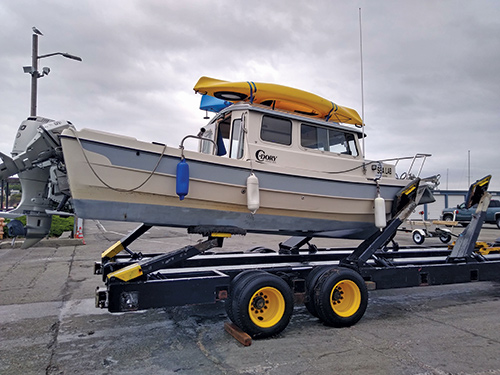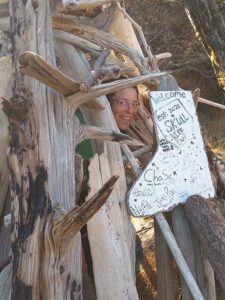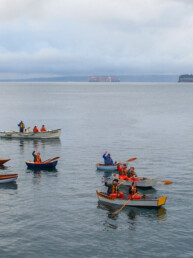Powerboat cruising is fast and fun… when the engine works!
Several days into our thus-far blissful and easy summer cruise on our new-to-us C-Dory 22, Sea Lab, we landed in Edmonds to refuel. My partner in life and cruising, Tekla, did a sailorly job of securing us to the dock and we moved efficiently through the stop. This was our first long cruise with the boat and we were eagerly anticipating our opportunity to explore more of the San Juan Islands thanks to our increased pace of travel — novel for us after cruising sailboats for 20 years.
Back on the water, we raced to an old favorite — Whidbey Island’s port of Langley — only to find the marina completely full. It was windy, and the bouncy conditions in the bay discouraged us from anchoring for the night. The only thing to do was to continue north and look for a more sheltered spot.
The northerly wind was predicted to continue with deteriorating weather, so we were a little anxious about finding a good spot along Saratoga Passage. We’ve experienced some rough water through there, and we were not looking forward to a turbulent night with little sleep. We poked into Elgar Bay on the Camano Island side and it didn’t seem protected enough. We looked in at Holmes Harbor and it seemed like a long way back to where protection would be. “Why not just keep on to Oak Harbor?” Tekla suggested, and the decision was made. As longtime sailboat cruisers, it hadn’t taken us long to grow accustomed to our new speedy mode on the water, so why not use it?
With our previous boats, we would have been beating up the passage and would have arrived very late in Oak Harbor. In Sea Lab, we can go straight there but, boy howdy, when the sea gets choppy the speed doesn’t work. Well, maybe it works but we can’t take the pounding. The C-Dory is shaped to be stable and plane at a low speed, but it has nearly zero deadrise at the transom so the hull is not built to be comfortable at speed in rough water like a deep-V. Travel is still rapid though, compared to our other transits of these waters. We could still make 8-10 knots in the direction of our destination, so I can’t complain.
We were about 3 miles from the first buoy marking the long entry to Oak Harbor when suddenly the sound of a loud buzzer coincided with the engine slowing to idle speed. What the heck? I shut the motor down and let it rest while we collected our thoughts. It started back up with the first turn of the key but wouldn’t go above idle. Paging through the engine manual, I discovered that this condition arises as an overheat protection, so it was time to run the kicker.
I had started the 15-hp kicker only once before, but this time I needed it. I donned my PFD and went back to lower the motor and get it going. Choking and pulling the starter rope got it going without too much trouble; but the twist throttle was made finicky by some corrosion on the cable connection. The motor would either race or die from idling too slowly. I was finally able to get it into gear and get going forward at just about sailboat speed.
It had not occurred to me yet that I could lock the steering on the little motor and steer from the helm using the big motor as rudder, so I stood at the stern hand-steering, the wind and waves spraying me as we puttered along. The entrance to Oak Harbor always feels long, and we finally made it to the marina, taking a spot just inside the breakwater.
After we got settled into our slip, I took the engine cover off of our primary Honda outboard to see if maybe the problem had a simple explanation. That happens, right? I was pretty well versed in the troubleshooting and repair of the old Yanmar on our Cal 27, Moon Dance, so I had to give this a shot. Under the engine cover, a baffling array of carburetors, hoses, and wiring was packed into an amazingly small space. If I was going to fix anything, it had better be an obvious problem with an easy repair. Hmm… I found a bad looking connection terminal that goes to the thermostat sender. Suspicious. I cut the wire, and replaced it with a better connector we had in our kit, with the audacious hope that the problem was solved.
Being Saturday night in the navy town where I had been stationed in the late 1970s, I figured we were in for a good time. Blithely, we proceeded into town for dinner and a beer where I could tell Tekla some of my “sea stories” of the time I spent here, while feeling modestly assured we could make the slack through Deception Pass in the morning.
In the morning after coffee, I apprehensively turned the key, she started right up, and we let go of the cleats. Idling out of the harbor everything seemed normal and, once we were in the lane away from the bay, I pressed the throttle forward and brought Sea Lab up on a plane. We were about to turn north at the channel marker, and my apprehension was just beginning to ease, when the buzzer went off and the motor shut back down to idle. The pit of despair yawned before me. I shut the motor down and went back to lower the kicker and we slow-motored our way back into the slip we had left an hour before.
There’s no outboard help to be found in Oak Harbor on a Sunday, so we enjoyed the day — hey, we were on vacation! We wandered off the marina grounds and had a great time in town, first at the Pacific Northwest Naval Air Museum and then at Penn Cove Brewing Company. Being stranded with a malfunctioning outboard is better with beer.

First thing Monday morning, we went looking for engine help. The kind attendant at the Oak Harbor Marina office directed us to Max the marine mechanic. In a quick phone conversation with him, we determined that he could be there as soon as we could get the boat out of the water and blocked into the yard. We walked to the boatyard and were set-up for immediate haulout, so we kicker-motored Sea Lab over. We were met by a contraption straight out of a Mad Max movie — an ancient semi-truck hooked up to a trailer with all kinds of hydraulic actuators being backed slowly into the water. With the soundtrack of whirring actuators, Sea Lab was lifted onto the trailer and pulled out.
Max arrived a short time later and we talked as he began taking things apart. He thought the most likely problem was the thermostat, and had already ordered a thermostat, sensor, and impeller from the parts place in Mount Vernon. Max mused that it looked like someone had been chasing this problem before, as the parts he removed seemed relatively new and the engine looked well maintained in general. When everything was reassembled and we had settled our bills, they hauled us back to the water with hopes that our problems were solved.
We headed out for a sea trial and everything seemed to work, but it was late in the day and, with a small craft advisory forecast, we turned back to the marina for one more night in the safe haven and one last crack at Penn Cove Brewing.
Tuesday morning dawned drizzly and dark gray, but with a clearing forecast. We had decided to forego Deception Pass and try the Swinomish Channel, so we would be closer to the marine services in Anacortes should we encounter further trouble. After coffee had brightened our day a little, we tanked up on fuel and made our way to the channel markers across Saratoga Passage. We lined up on the day markers indicating the channel entrance and headed in — so far, so good with the motor. The weather dried up as we arrived at Cap Sante Marina, and we prepared for an afternoon of exploring Anacortes.
The next morning, we awoke to fine weather and were ready to finally arrive in the islands. With the motor’s reassuring performance the day before, we felt confident about running around in the islands for a week and were really looking forward to it. Sea Lab felt good as we turned north from Guemes Channel into Bellingham Channel and across to Eagle Harbor on Cypress Island. We grabbed an open state park buoy, had a quick lunch, and launched the kayaks to go in for some much needed exercise.
The hiking on Cypress was as good as we remembered. We made the summit of Eagle Cliff and took in the breathtaking view of the islands to the west. On the way down, we checked out Smugglers Cove and found it deserted and decided to linger there. We love sitting on the fabulous gravel beaches of the San Juans just to watch the water flow by and poke through the gravel.
We finally decided it was time to return to Sea Lab and get some dinner going, and we kayaked back to the buoy where she was tethered. There is a small swim step on the port side to clamber onto for boarding and I always go first so I can help Tim Tim, our sailor dog, back aboard since he rides with Tekla in her kayak. He’s pretty good at making the transition, but I always want to be there to help him in case he needs it. After he was on board, I gave Tekla a hand, but this transition is awkward and we’ve only done it a couple of times on this boat and we haven’t settled into a routine with it. All of a sudden, the kayak slipped out from under her like a banana peel under a clown and in she went! From the water, getting aboard was much easier because she could pull herself onto the boarding ladder and up onto the step, unharmed but wet and salty. In our previous twenty-some years of boating, we’ve never had anyone go into the water accidentally and we always wear PFDs when the possibility of going overboard exists. We were prepared, but it was still a big surprise and now we had a pile of soggy, salty clothes to dry.
Everything was wetter the next morning, like it usually is in the cool marine environment. We moved along on our loosely planned journey, headed west and north, refueling at Blakely Marina. We bucked the fading ebb back through Peavine Pass thinking about making the outer island of Clark or Plan B: Sucia. Since we expected things to be crowded for Labor Day, there would be plenty of room at Sucia.
Following the east shore of Orcas, we passed between it and tiny Doe Island with its tiny dock and, to our surprise, one side of the dock was empty. We had never stayed here before, as every time we had passed the dock was full. So, we pulled in and tied up to meet our new neighbors, Vernon and Shirley, on their Canoe Cove 45 with a large crew of friendly and boisterous grandkids. It’s great to see curious kids in this environment learning new things around every corner.
Doe Island was a treat and is now another one of our favorite spots. We spent two nights, hiked the whole island, and explored every beach both on foot and by kayak. The currents in the pass between Doe and Orcas are great fun to ride in kayaks.
It was Saturday night and, looking at the chartbook over dinner, we thought we should try our Clark/Sucia plan the next day. We got an early start on Sunday morning, and arrived at Clark to find it full; so on we went to Sucia and settled into Snoring Bay with one other boat, a big beautiful sailing catamaran. Right away, we got the kayaks in the water and brought Tim Tim in for his relief tour of the beach and then continued our paddle tour of Snoring Bay with its crazy beautiful rock formations against soft blue late summer sky.

We were at the point of our summer cruise where we had to start cruising toward home, but we had one more spot we really wanted to try. In the old but fabulous book Gunkholing in the San Juan Islands, Jo Bailey and Carl Nyberg include a description of anchoring behind Skull Island at the very head of West Sound in Massacre Bay. It’s shallow and rocky there, and we had tried it twice before in our sailboat and both times chickened out as the tide began to fall and the rocks began to show. Drawing only one foot of water on Sea Lab, we decided this anchorage would be a cinch, so we pointed our bow in that direction in calm sunny weather and smooth water.
On our way from Sucia, we needed to stop for fuel and re-supply in Deer Harbor, where they have a nice little grocery adjacent to the fuel dock. We climbed the plank for food and found that late season grocery shopping in the marina is quite limited. It turns out they let their stock run low because their customer base all leaves after Labor Day.
With ample additions to our tanks and meager ones to our larder, we had favorable current through Pole Pass and rounded north into West Sound. We arrived in Massacre Bay early in the afternoon and no one was in our spot. We passed through a few times sounding where the rocks were, picked our spot, and pushed the button. I felt the anchor get a good dig, it was fantastic weather, and there had been no more motor troubles, plus there was a little left in that box of Syrah. Glory days!
We circumnavigated the island in the kayaks before landing on the broken shell beach and exploring on foot. It’s difficult to describe the feeling of being on a tiny, deserted island with nothing to worry about surrounded by a world full of trouble. I relish every second of it.

After sleeping like babies in our rocking crib, we lingered in the morning to time our arrival at Deception Pass correctly, before continuing back to Langley for our last night. We hoped for a nice dinner in town and a shower before pulling Sea Lab out of the water the next day in Port Townsend. We just weren’t ready for a crossing of the Strait of Juan de Fuca in Sea Lab. Everything was nice and easy through the pass and we made Langley in plenty of time to realize our plans, after a 56 nautical mile run — distance we never would have contemplated sailing.
After casting off from Langley, we were rounding the southern end of Whidbey when the buzzer sounded and the engine spun down to idle. Max had told me, if it happened again, to just let it idle and cool down and that’s what I did. Back to sailing speed. At least this time, I knew what was going on and it didn’t spike my anxiety. We idled along for a while, and I tried running back up on plane and it went…for a minute. After a couple more cycles of heating up and cooling off I found the speed I could keep without the sensor shutting me down: 6 knots. Not bad. We spent 20 years below 6 knots and loved every minute; another couple hours to make Port Townsend was all part of the trip. The weather was beautiful, and we enjoyed favorable current through the Port Townsend cut to round out the journey. My cruising partner was by my side and all was well on the water.
 In the weeks that followed, a boating friend told me about someone who had chased that same problem with an outboard of similar size, and it had turned out to be a cooling passageway that had become partially blocked by a piece of rubber from the impeller. Tekla and I had a great summer cruise, but the worry and potential for future engine failure led us to determine the best option was to repower. Yes, it was expensive, but we did it and our cruising adventures since have been worry free!
In the weeks that followed, a boating friend told me about someone who had chased that same problem with an outboard of similar size, and it had turned out to be a cooling passageway that had become partially blocked by a piece of rubber from the impeller. Tekla and I had a great summer cruise, but the worry and potential for future engine failure led us to determine the best option was to repower. Yes, it was expensive, but we did it and our cruising adventures since have been worry free!
Dennis and his mate, Tekla, reside in Auburn, WA and now keep Sea Lab in the water at Tyee Marina.
Dennis Bottemiller
Dennis and his mate, Tekla, reside in Auburn, Washington and usually launch from Point Defiance to spend time on Sea Lab, their C-Dory 22 affectionately nicknamed “Boatswagen Bus.” When not playing with boats or guitars, Dennis can be found tending tropical Rhododendrons at the Rhododendron Species Botanical Garden.






